originally posted at https://canmom.tumblr.com/post/162580...

A third of the cast has been murdered and the Seventh Pentagram of the Sun painted on the door.
Battler is determined to find a non-supernatural explanation. Maria, Genji, Kanon and Kumasawa all believe the witch Beatrice is responsible (she ‘exists’!). Eva suspects one of the survivors dunnit, and favours the servants. George and Jessica are grieving and not much in a state to play detective. Nanjo hasn’t ventured a hypothesis. Kinzo is missing.
Comments
I got some interesting asks from @fates0end, clarifying the different versions of the game!
Alright, glad to see an Umineko livereader! Always fun to see someone experience it for the first time.
Okay, so there’s some things I should tell you about the PS3 patch (the art and voices you’re using). None of the decisions on the art or voices necessarily reflect the intent of the author. Especially the CGs/closeups, which did not exist in the original.
Second, the opening videos are very different from the original, and there are more; three for the first half, two for the second, as opposed to one for each half, and the second PS3 opening is EXTREMELY spoilery and only recommended to be viewed after the seventh episode. If you’d like, the original first opening is youtube video f184GruHq9o , though I’d recommend you watch it on the polsy website (by searching for the video, copying the youtube URL, finding polsy via google, and pasting the link into the alternative video viewer) to avoid related videos and comments. Welcome to Rokkenjima.
Thanks, that’s interesting to know! I’m surprised the original author didn’t have creative input into the PS3 version, but it’s good to know.
I’ll definitely take artistic decisions like Maria’s expression when she talks about the Seal of Solomon with a pinch of salt. I’m not sure if the umineko-project release inserts the spoilery PS3 opening in that place in the narrative - we’ll see, I guess!
I hope you’re enjoying the liveread :)
@mellifluouslutrinan notes that the pentagram originates in a Victorian grimoire falsely attributed to King Solomon, the Key of Solomon. The relevant page is here.
@quizzicalqueek, thanks for the positive comments :)
Detective hats on
Where we left off, the cousins were discussing child psychology, trying to understand why Maria got so into the occult thing.
There’s some talk about gender stereotypes about what kids get into to make themselves stand out. Apparently girls tend to get into fortune telling and supernatural stuff, as opposed to physical stuff for the boys? I’m not sure I grew up with a similarly gendered view of fortune-telling. Patriarchal capitalism generally encourages girls to be into princesses and horses rather than magic. We did have those little paper fortune telling things, but I don’t remember a gendered dimension to their use.
George says girls are ‘more introverted’ than boys, and like that seems like the opposite stereotype than I’m used to? I remember growing up hearing that girls develop socially faster than boys and stuff like that. (Obviously viewed as some kind of natural tendency rather than a product of gender socialisation).
From this wild generalising about gender, they decide Maria’s occult interest isn’t that unusual. Maybe, but knowing every pentagram from the Key of Solomon by sight might be.
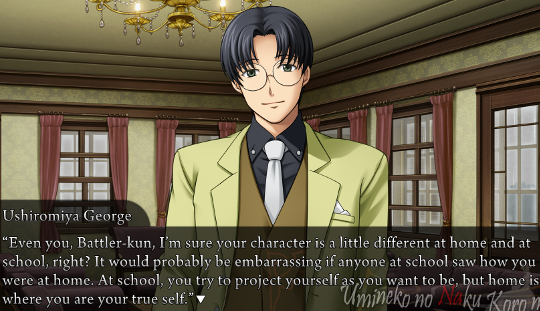
I dispute the idea that the ‘home’ self is the ‘true’ self, or the idea of the ‘true’ self in general, but eh. It goes on in this vein.
We learn a bit about how Rosa raised Maria…
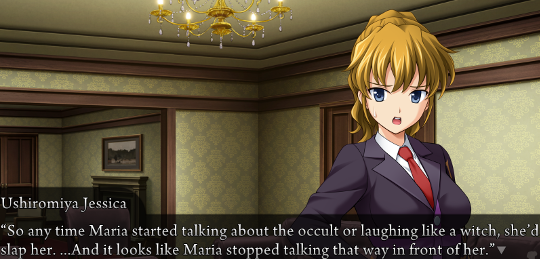
:(
To Battler asking, Jessica explains that doubting Beatrice’s existence (or perhaps ‘existence’) is taboo in the mansion, thanks to Kinzo. They discuss whether the servants really believe, and conclude they take it seriously, as a ghost story at least. Battler compares it to the legend of Inari and the kitsune, and other superstitions ‘still’ taken seriously.
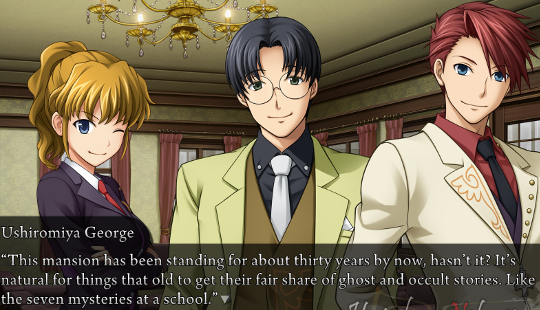
Thirty years doesn’t seem that old to me? Like, brutalist buildings from the 80s don’t seem to get many ghost stories :p
But like, maybe a mansion gets ghost stories by default.
Battler gets a chance to ‘flip over the chessboard’. I really want to add a chessboard flip counter, but I haven’t been keeping track. Maybe I could search the script… in any case, he concludes that the culprit must be exploiting the Beatrice legend to suggest it’s the witch, i.e. a 19th person. He questions whether a 19th person ‘announcing themselves’ would do it at a time when there’s plenty of grounds for suspicion on one of the others.
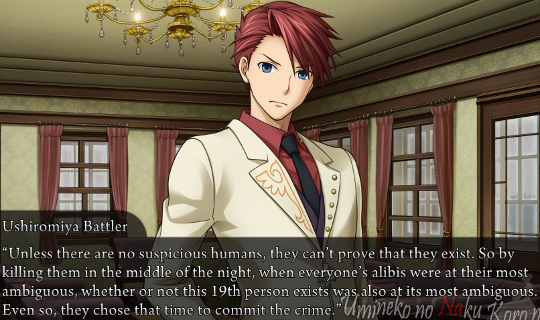
So this leads Battler to suspect one of the 18 is responsible and trying to put the blame on a fake person.
George brings up Beatrice’s reference to collecting ‘interest’ for the gold, of ‘everything of the Urishomiya family’. Possibly including members of the Urishomiya family. They conclude, on that basis, that the culprit didn’t kill everyone at once in order to give the rest of them a chance to solve the riddle.
Eva questions why, if someone was trying to encourage people to solve the riddle through violence, they wouldn’t just threaten Kinzo. So Battler suggests this is a message directed not at the guests, but at Kinzo to make him reveal the gold.
The problem is that this would require Kinzo to actually care about his family members!
Eva starts prodding the servants about whether Kinzo’s study has any hidden doors. She (and later Hideyoshi) keeps telling George to shut up whenever he tries to participate in the conversation. I don’t really get that.
With nobody knowing about a hidden study, she levels an accusation. She announces she stuck a receipt to the door of the study when she met Natsuhi earlier, and it was still there in the same place when they returned to the study, suggesting the door had not been opened in the intervening time. Implied accusation: Natsuhi had something to do with Kinzo’s disappearance, or lied about his presence that morning. (Having watched their conversation, we know Kinzo was there, but the characters have no such insight).
Eva suggests Natsuhi had killed Kinzo, and was arranging matters to give herself an alibi when she ‘discovers’ the body later. Or else the body will never be discovered, delaying the distribution of Kinzo’s estate for as long as it takes for a missing person to be declared dead.
Then, things take a dramatic turn.

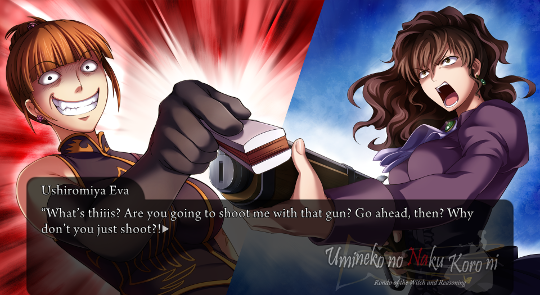
Given what fates0end said above, it’s worth noting that the narration makes no mention of Natsuhi pointing the gun at Eva, despite the illustration.
In fact, a moment later, the narration says she hadn’t been pointing the gun until Eva suggested it.
Eva demands Natsuhi explain how Kinzo left the room. Of course, there’s no reason Natsuhi would know that?
Eva suggests an alternative idea: that Kinzo was in the room, and Natsuhi pushed him out the window, then hid the body under pretense of checking the house. But… why would she do that? Hideyoshi agrees with the accusation.
Eva’s accusation is accompanied by a dramatic violin piece. Battler joins the discussion, and ‘Core’ kicks in, so it’s time for some hardcore detectiving.
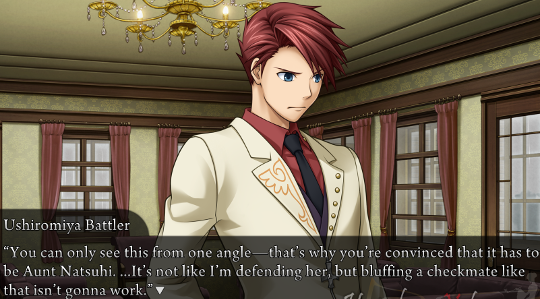
And, of course, chess metaphors.
Battler says Eva’s theory would get a ‘65 at best’ in class. Detective class. For murder mystery detectives.
With a lot of bluster, Battler argues that Kinzo could very well have hidden somewhere inside his room, and escaped after Eva and Natsuhi entered. He calls it check, but not checkmate, and calls Eva on pressuring Natsuhi to explain what happened. It gets almost Phoenix Wright…
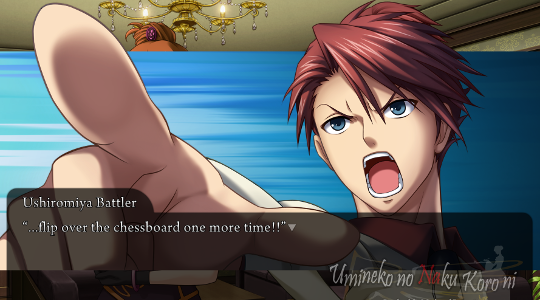
I made a graphic for all the chessboard flipping that’s going on.
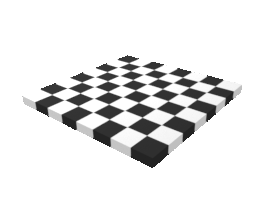
To demonstrate the flaw in this approach, he demands Eva and Hideyoshi explain how they’re innocent; overall point: you can’t just accuse someone and demand they explain their innocence.
The accusations and counter-accusations are interrupted by Jessica having an asthma attack. They resolve to leave it to the cops. When the typhoon passes and the seagulls come back…
……It will definitely be resolved - even if we do nothing - when the seagulls cry.
Title: dropped.
Comments